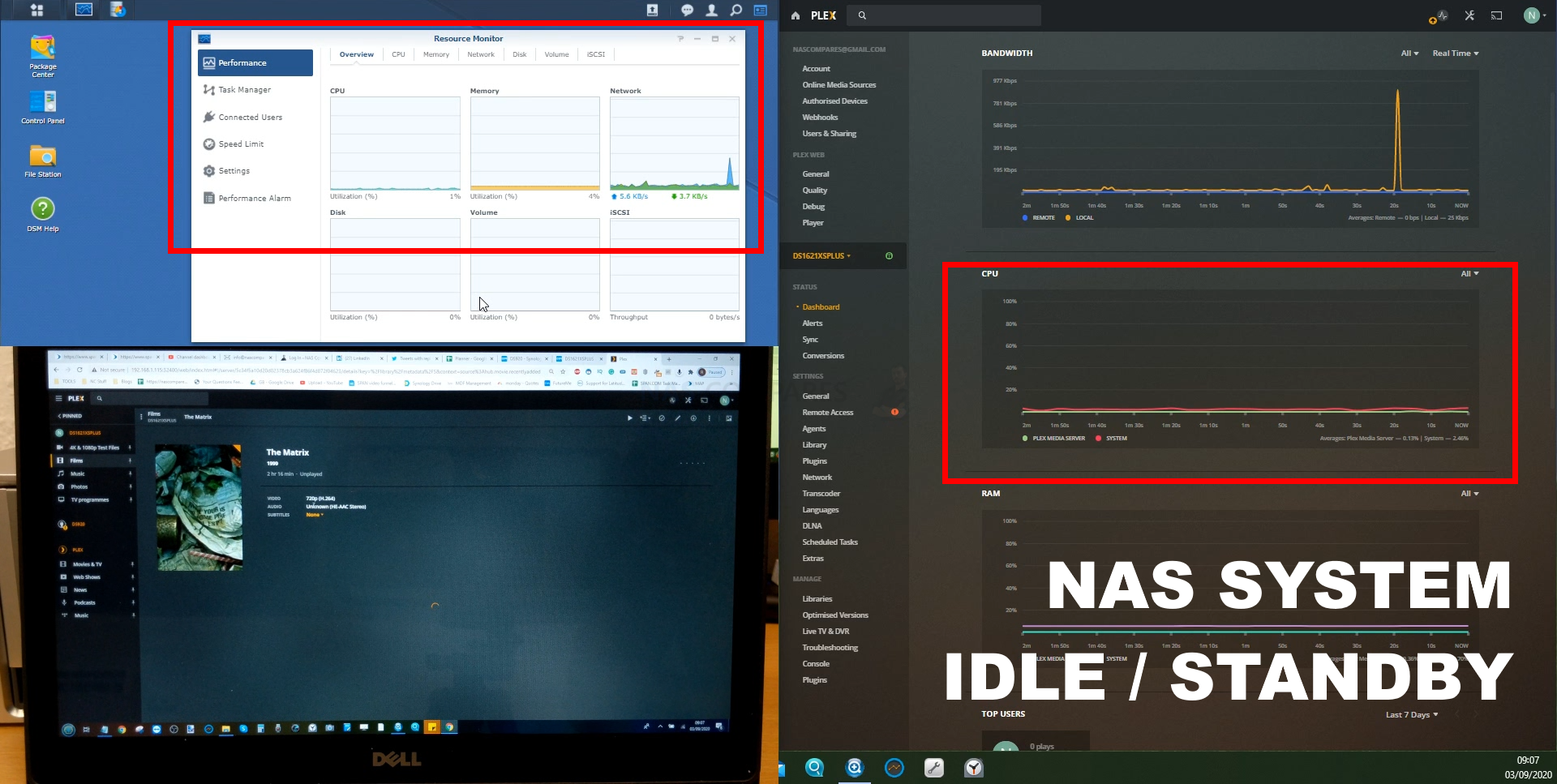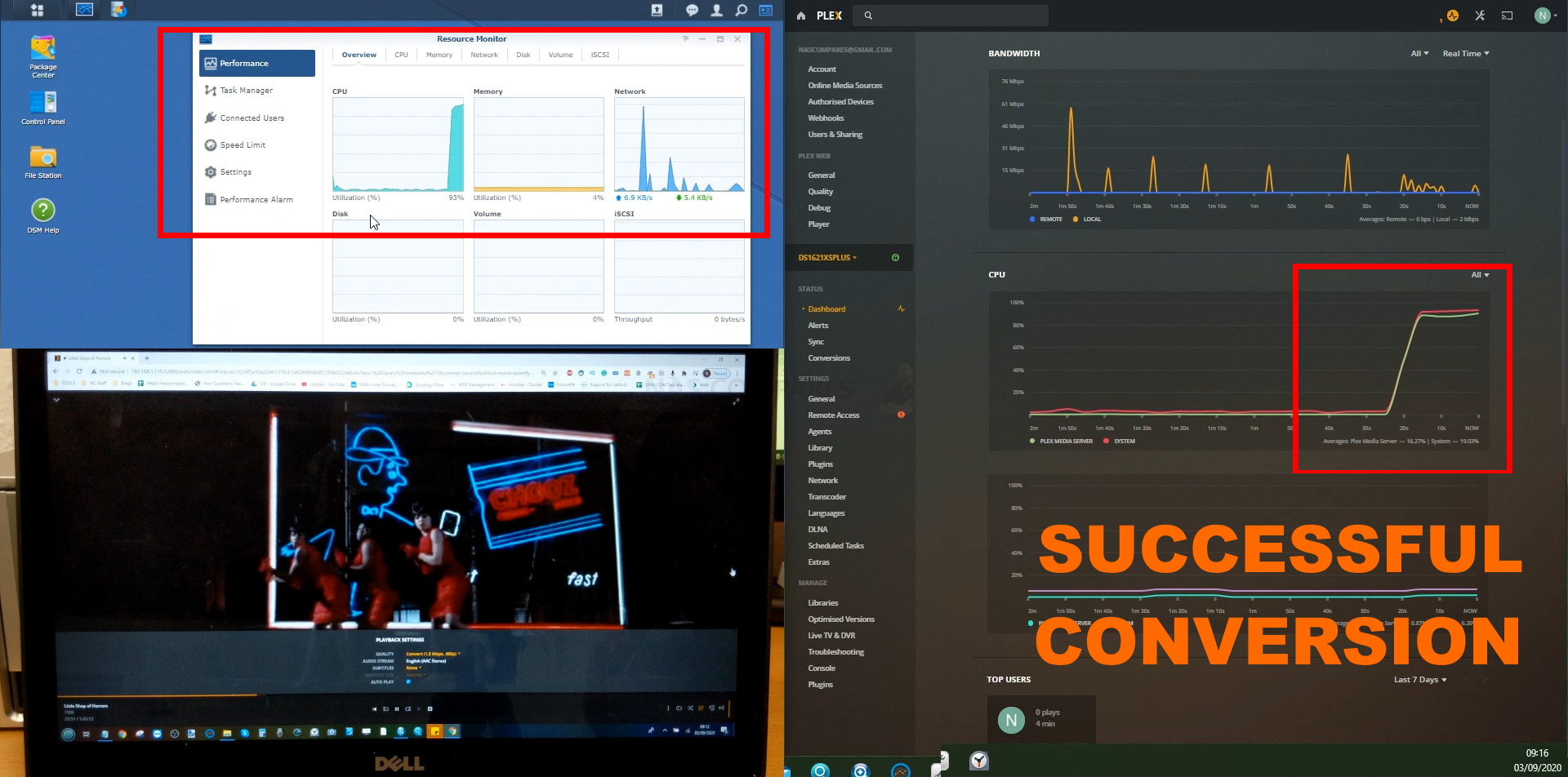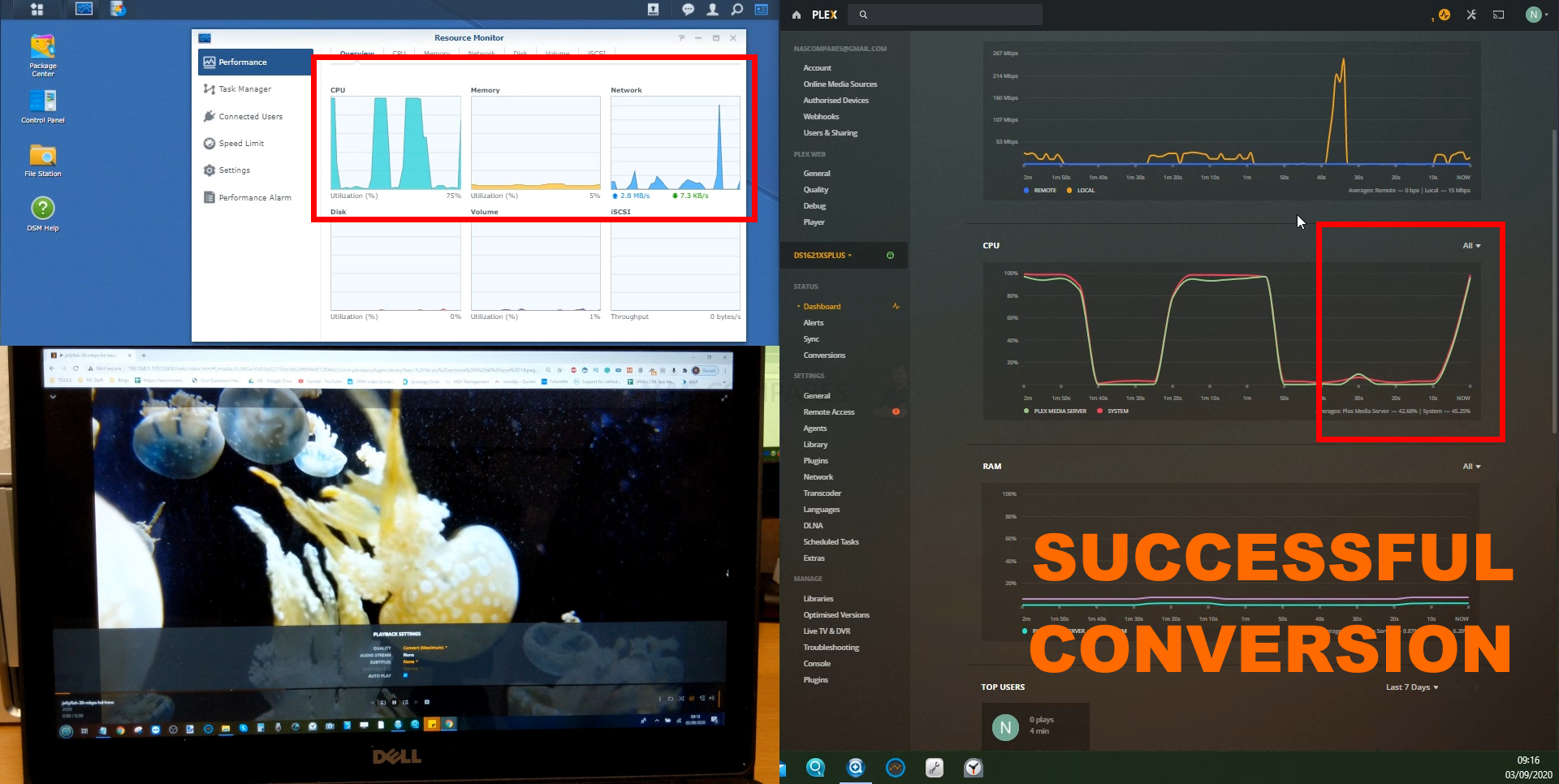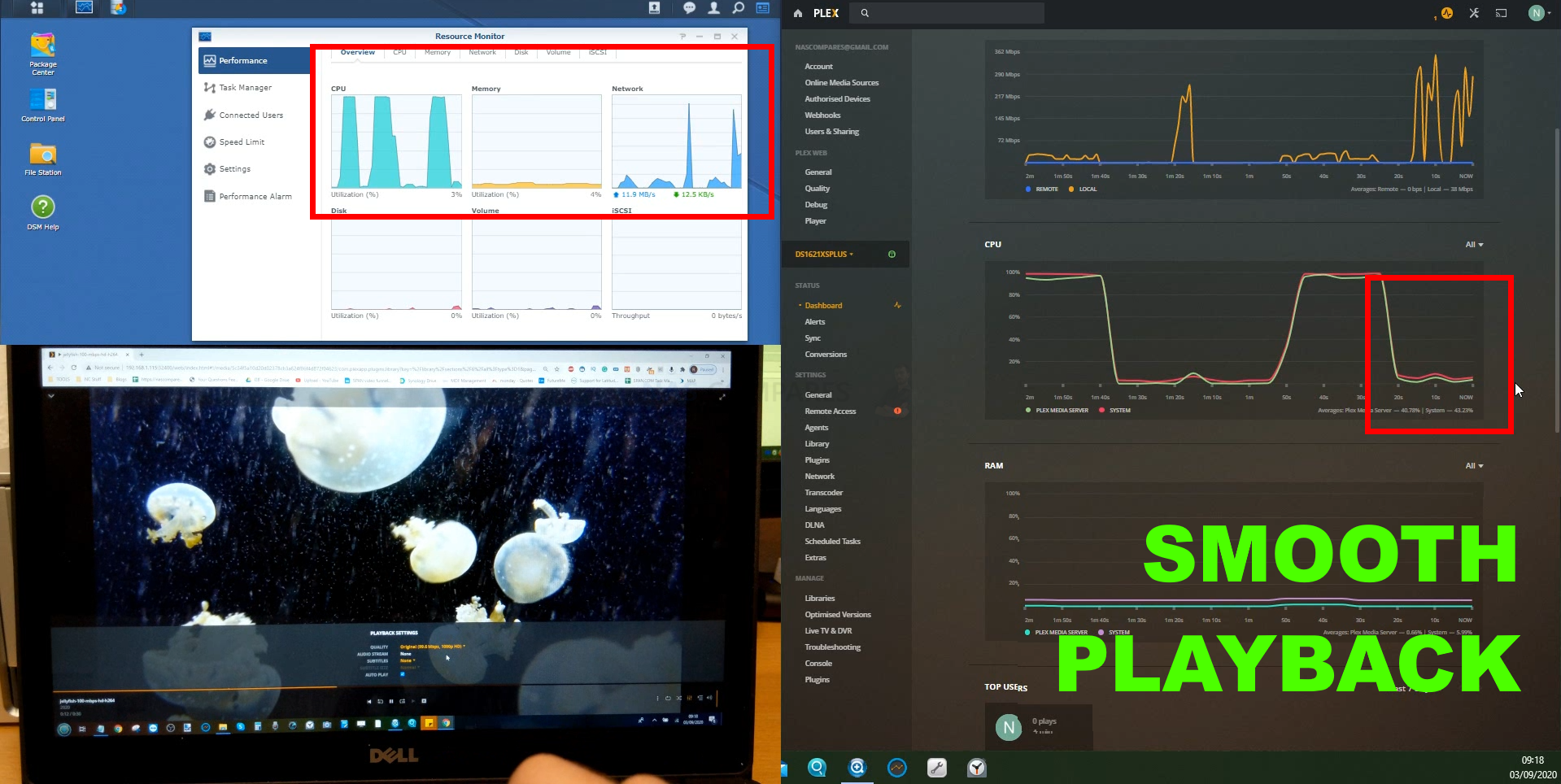Transcoding 4K Media on the DS1621xs+ NAS Plex Media Server
Smooth playback of high end media on a NAS is always something that you cannot really cheap-out on. if you are investing in a new NAS system and are looking for a solution that will last for a good few years alongside your TV/Sound system, then you need to choose wisely. This also applies to choosing a Synology NAS that will have the horsepower to convert your big, BIG files into something more suitable with your mobile devices, tablets and more – known as transcoding. Transcoding on a NAS such as the DS1621xs+ device is the ability for a multimedia file to be changed from it’s existing format or codec to one that is better suited to the destination device. In this file access, the DS1621xs+ NAS is the host device and the device you want to play the file is the client. This is the case of whether you are using Plex or not. Transcoding is typically required when a media file is more recently released than the client device that is accessing it, so the newer compression or playback format is unknown to the device you want to access it with. Alternatively, you want to access the movie or music on your DS1621xs+ and do not want to use the original file in its full size. Transcoding can enable you to stream a much smaller version in weight or resolution if needed. In a popular program such as PLEX, smooth playback is essential, and with the plex media server application on the DS1621xs+ NAS using a larger percentage of CPU and Memory than most programs, it is very useful to know the plex transcoding abilities of any NAS.
Why should you factor transcoding with a Plex Media Server on a DS1621xs+ NAS
When you install a Plex Media Server on your DS1621xs+, you should know that plex is not the answer to all of your media prayers. It has some limitations and depending on the NAS you use, these limits can be annoying. You will most likely have media files in a large collection of different formats and there is no guaranteeing that these are going to be compatible with TVs, iPads and Smartphones that you wish to watch them on. Although you will have a version of the Plex app on the viewing device, that app will still be locked to playback the supported media types on that device.
So if your phone does not support .MKV or .MOV, then neither does the plex app you installed on it. However, this is where transcoding comes in again, as the plex media server will use the NAS system resources to change the file to a version/format that it CAN play. What makes transcoding with Plex different to ordinary transcoding is that often, the NAS (in this case, the DS1621xs+) will not let the plex use the transcoding engine inside. This is not the end of the world, as it will use raw system power instead. The result is that where a regular transcode outside of plex will use 20-30%, in plex it could go as high as 70-80%. This is why it is important to know how well a plex NAS will transcode, as if it will happen regularly, it could potentially slow down the general use of your DS1621xs+ NAS. In the case of Xeon based NAS devices (such as the Synology DS1621xs+), these processors do not feature embedded graphics components (AKA a transcoding engine) and therefore they will require the system to use raw CPU power to get the job done. This is less efficient than a GPU-assisted processor like an Intel Core or AMD Radeon, but it makes up for it with just having more power.
Which Plex supported client devices require transcoding from the DS1621xs+ NAS
Destination devices range greatly and are often referred to as the client device. Common client devices that your DS1621xs+ device will be accessed by are often:
- iPad or Android Tablet
- iPhone or Android Smartphone
- Smart TV or DLNA supported monitor
- MacBook, Laptop or Netbook device
- Sound systems such as Bose, Sonos and Sony DLNA systems
- Home Theatre Systems
- Network and internet-enabled gaming consoles such as PS4, Xbox One and Nvidia Shield
Transcoding between a DS1621xs+ and your media can be of tremendous benefit for those with limited internet bandwidth, download limits or low powered devices whilst using the plex client application.
What are the Specifications of the DS1621xs+ NAS?
The specifications for the DS1621xs+ NAS are below and like all NAS devices, the CPU and Memory play a big part in how well it performs at transcoding both in and out of plex. The key factors to consider are if the device features an x86 or ARM-based CPU, does the DS1621xs+ CPU feature a transcoding engine (sadly not) and how much RAM the device arrives with for multiple transcoding tasks (8GB by default, going up to 32GB). Below are the DS1621xs+ specs:

The Synology DS1621xs+ 4-Bay NAS – £1650+
SPECS – CPU TRANSCODING ENGINE: NO 1080P Support: YES 4K Support: YES Transcoding Support: YES, SOFTWARE
If you are thinking of buying a Synology NAS, please use the links below
|
|||||||||||
What is the difference between H.264 and H.265 4K Media on a NAS
H.264 and H.265 are common codecs of modern digital media. H264 is also referred to as AVC by experts (Advanced Video Coding) and is considered the standard for video file compression. This allows for media originally created for large-scale entertainment to be recording, compressed, and distributed to the home and smaller-scale production of digital video content watched by you, the consumer via Plex. H265 is the newer and more consumer-friendly alternative to H264. It is also known as HEVC (High-Efficiency Video Coding) and was developed in order to resolve issues of enormous 4K media files being just too large for your client device to playback. H.265 has become so popular and data saving that chances are that the YouTube clip, iTunes media or iPlayer content you watched was in .265 and HEVC. One issue of H.265 however does have it’s own drawbacks, with many NAS devices being unable to playback the media by default for licencing reasons, CPU incompatibility or the graphics driver that Plex uses in the system not being suitable. Typically a modern NAS such as the DS1621xs+ will playback with JUST H.265 or H.254, or it will Playback both H.264 and H.265. The latter pretty much being exclusive to x86 or AMD based NAS CPU devices.
The DS1621xs+ NAS Plex Tests – Idle/Standby
To get a better idea of what is considered ‘normal running’ in plex, we installed plex media server, along with a handful of video files that covered SD, 720p, 1080p and 4K, each at either H.264, H.265 (HEVC), UHD, 10bit or a combination of some/all of them. Here is how the NAS looked when in standby/idle (I have circled the important things to look at:
Synology DS1621xs+ NAS Plex Test 1 – 720p 0.7Mbps 23FPS – How well does it perform?
Synology DS1621xs+ NAS Plex Test 2 – 720p TRANSCODE to 160P 0.7Mbps 23FPS – How well does it perform?
Synology DS1621xs+ NAS Plex Test 3 – 1080p 1.9Mbps 23FPS – How well does it perform?
Synology DS1621xs+ NAS Plex Test 4 – Trancode 1080p 1.9Mbps 23FPS –TO– 480p 2Mbps – How well does it perform?
Synology DS1621xs+ NAS Plex Test 5 – 1080p 3Mbps H.264 30FPS – How well does it perform?
Synology DS1621xs+ NAS Plex Test 6 – CONVERT 1080p 3Mbps H.265 30FPS – How well does it perform?
Synology DS1621xs+ NAS Plex Test 7 – 1080p 10Mbps H.264 30FPS – How well does it perform?
Synology DS1621xs+ NAS Plex Test 8 – 1080p CONVERT 10Mbps H.265 30FPS – How well does it perform?
Synology DS1621XS+ NAS Plex Test 9 – 1080p 30Mbps H.264 30FPS – How well does it perform?
Synology DS1621XS+ NAS Plex Test 10 -CONVERT 1080p 30Mbps H.265 30FPS – How well does it perform?
Synology DS1621XS+ NAS Plex Test 11 – 1080p 100Mbps H.264 30FPS – How well does it perform?
Synology DS1621xs+ NAS Plex Test 12 – CONVERT 1080p 100Mbps H.265 10BIT 30FPS Automatic Plex Settings – How well does it perform?
Synology DS1621xs+ NAS Plex Test 13 – TRANSCODE 4K 120Mbps H.265 10BIT 30FPS Automatic Plex Settings – How well does it perform?
Synology DS1621XS+ NAS Plex Test 14 – CONVERT 4K UHD 400Mbps H.265 30FPS TO Plex Recommended – How well does it perform?
I hope these Plex Media Server 4K results were of use to you and this helps you consider which NAS you wish to you buy in 2020, whether it is the DS1621xs+ or something more or less suited to your needs.
Read the Synology DS1621xs+ NAS Drive Review Below (click)
📧 SUBSCRIBE TO OUR NEWSLETTER 🔔🔒 Join Inner Circle
Get an alert every time something gets added to this specific article!
This description contains links to Amazon. These links will take you to some of the products mentioned in today's content. As an Amazon Associate, I earn from qualifying purchases. Visit the NASCompares Deal Finder to find the best place to buy this device in your region, based on Service, Support and Reputation - Just Search for your NAS Drive in the Box Below
Need Advice on Data Storage from an Expert?
Finally, for free advice about your setup, just leave a message in the comments below here at NASCompares.com and we will get back to you. Need Help?
Where possible (and where appropriate) please provide as much information about your requirements, as then I can arrange the best answer and solution to your needs. Do not worry about your e-mail address being required, it will NOT be used in a mailing list and will NOT be used in any way other than to respond to your enquiry.
Need Help?
Where possible (and where appropriate) please provide as much information about your requirements, as then I can arrange the best answer and solution to your needs. Do not worry about your e-mail address being required, it will NOT be used in a mailing list and will NOT be used in any way other than to respond to your enquiry.

|
 |
The BEST NAS of 2026.... ALREADY??? (UnifyDrive UP6)
How Much RAM Do You Need in Your NAS?
A Buyer's Guide to Travel Routers - GET IT RIGHT, FIRST TIME
Jonsbo N6 DIY NAS Case Review
The Best Bits (and Worst Bits) of NAS of 2025!
Minisforum MS-02 Ultra Review
Access content via Patreon or KO-FI
Discover more from NAS Compares
Subscribe to get the latest posts sent to your email.
























Thank You for the Info, you were helping me to understand from a place that could of taken my own guesswork, even though your knowledge is complex, you know what your talking about!
REPLY ON YOUTUBE
I have a bunch of DVD’s, some BlueRays that I want to download to a Plex server what is the best way and format to do that in?
REPLY ON YOUTUBE
Can you transcode on a Ugreen Nas?
REPLY ON YOUTUBE
Thank you for explaining this!
REPLY ON YOUTUBE
????????????????
REPLY ON YOUTUBE
can i also use this tutorial for my ds1821+? 4k hevc transcoding is struggling hard with cpu utilization at 100% on my nas and still buffering on my plex server (one stream only)
REPLY ON YOUTUBE
It’s 3 years later and on my Synology DS220+ the answer was the opposite. I had to add VaapiDriver=”iHD” to the Preferences.xml
REPLY ON YOUTUBE
I hate that 90 percent of home media center related videos on this site are made by this unlikable ghoul.
REPLY ON YOUTUBE
Is this relevant to do today on my 920+
REPLY ON YOUTUBE
so basically if i watch 4K mkv files from a nas on a 4K tv, there is no transcoding happening, thus the attributes of the nas is negligible ?
REPLY ON YOUTUBE
We are living in 2022 now. The DS920+ haves transcoding. The DS923+ does not have transcoding.
But I am not a heavy watcher. Do I still need transcoding?
REPLY ON YOUTUBE
Question?
So if I rip 4K uhd blu rays to a synology nas and play it using a pc,Apple TV 4K and phone. Do I have to worry about transcoding? And will i worry about transcoding if I were to rip older disneys dvd tbat are 720p or 1080p
REPLY ON YOUTUBE
Not working on ds220+. Plex wont start after edit the xml.
REPLY ON YOUTUBE
I have to ask. What if I update the NAS? Can this fix be repeated indefinitely? Btw what updates are we talking about? Because system updates should be pretty important for DSM stability and security if I have to avoid them
REPLY ON YOUTUBE
I ordered this NAS but while in transit to my door, I saw this review and realized that it doesn’t have the Hybrid RAID (SHR) that I guess ONLY the lower-end Synology NAS systems come equipped with. Why on Earth would Synology take OUT this useful feature from of a higher end model is beyond me! I hope that the folks here at NASCompares really sticks it to Synology so that they implement it into future higher-end NAS boxes.
I understand that SHR is perhaps not the most efficient of RAID configurations, but anyone who has HDDs of varying sizes like I do needs to use a Hybrid RAID otherwise there will be tons of wasted space. So instead of keeping the functionality in the higher end systems and allowing the user to decide what they want to use, Synology removes the feature and forces us to use a traditional RAID configuration where all the HDDs need to be the same size to fully utilize the space.
So, Synology, instead of getting $1,700 from me, you’re going to only get $700 on a lesser model when I return this one for one that has SHR…. and I’m then not as happy of a customer for getting something less than I was expecting. Boo Synology, Boo!
REPLY ON YOUTUBE
Can this be done on Qnap too? Like the same method? Want to know before I buy anything
REPLY ON YOUTUBE
Thank
REPLY ON YOUTUBE
SO i tried this today and followed your instructions and got an error that the file i edited was not in the proper format. And said i could save it if i wanted. Saved and then when to run plex again and it wouldnt allow plex to run. I had to delete it and bring it back to how it was. Is this fix still even needed?
REPLY ON YOUTUBE
What’s the point of having 4k HDR files if you use transcoding? Why do you need transcoding in first place? I don’t get it.
REPLY ON YOUTUBE
why is the DSM 7 version taken down?
REPLY ON YOUTUBE
great video! just a little typo: h.265 I assume?
REPLY ON YOUTUBE
I’m running a DS1918 and my xml file is not saving, getting an error. PlexOnlineHome=”0″ DlnaEnabled=”0″ VaapiDriver=”i965″ />. That is the last of the line for me. Thanks for any help
REPLY ON YOUTUBE
I hope this helps.
I was having permission issues saving the changes to Preferences.xml file.
Find a workarround for the H265 files playing issue.
Environment:
Samsung Q70R
DS920+
I’ve went to the settings on plex player app and changed the subtitles burn in to “burn in image formats only”.
When playing H265 movies, looks to me that Plex doesn’t like ASS files (at least on my devices)
With this, I didn’t had to change anything in Plex Preferences.xml file.
CPU running at 6% and playing H265 movie (size=30GB) without any breaks
REPLY ON YOUTUBE
Great vid
REPLY ON YOUTUBE
This does not work my plex media server is a snail with hardware acceleration when having subtittles without subs its super fast, this a straight insult after buying plex pass lifetime
REPLY ON YOUTUBE
Has anything changed between 2020 and now? When I try to edit the file I get a error message that I don’t have the proper rights to save the file. I have tried it with the administrator account and with a normal user with administrator rights.
REPLY ON YOUTUBE
Is it still recommended I do this in Oct 2021?
REPLY ON YOUTUBE
Anyone know if this issue was fixed with DSM 7? Thank you
REPLY ON YOUTUBE
I have exactly the same issue but or my DS1515+, is there a similar fix for that era of Synology NAS?
REPLY ON YOUTUBE
Can anyone confirm if this is still required on the current builds of plex (1.24.0.4921) on 920+ on DSM 7, cheers
REPLY ON YOUTUBE
For some reason when I do the steps on my DS920+ it just ruins my whole server and I have to remake it and the file is reset without the line added… does this not work anymore ?
REPLY ON YOUTUBE
How does this compare to the RS1619xs+? Considering both for large storage and remote editor server purposes. Haven’t decided on SSD or HDD, but leaning towards HDD for larger storage.
REPLY ON YOUTUBE